Disability Rights Movement: History, Leaders, and Impact
VerifiedAdded on 2024/01/17
|9
|2401
|230
AI Summary
This article provides an overview of the disability rights movement in the US, including its history, prominent leaders, and impact. It explores the demands made by the movement, the actions taken to bring about change, and the resulting changes in society. The movement aimed to empower people with disabilities, challenge discrimination, and promote inclusion and accessibility.
Contribute Materials
Your contribution can guide someone’s learning journey. Share your
documents today.
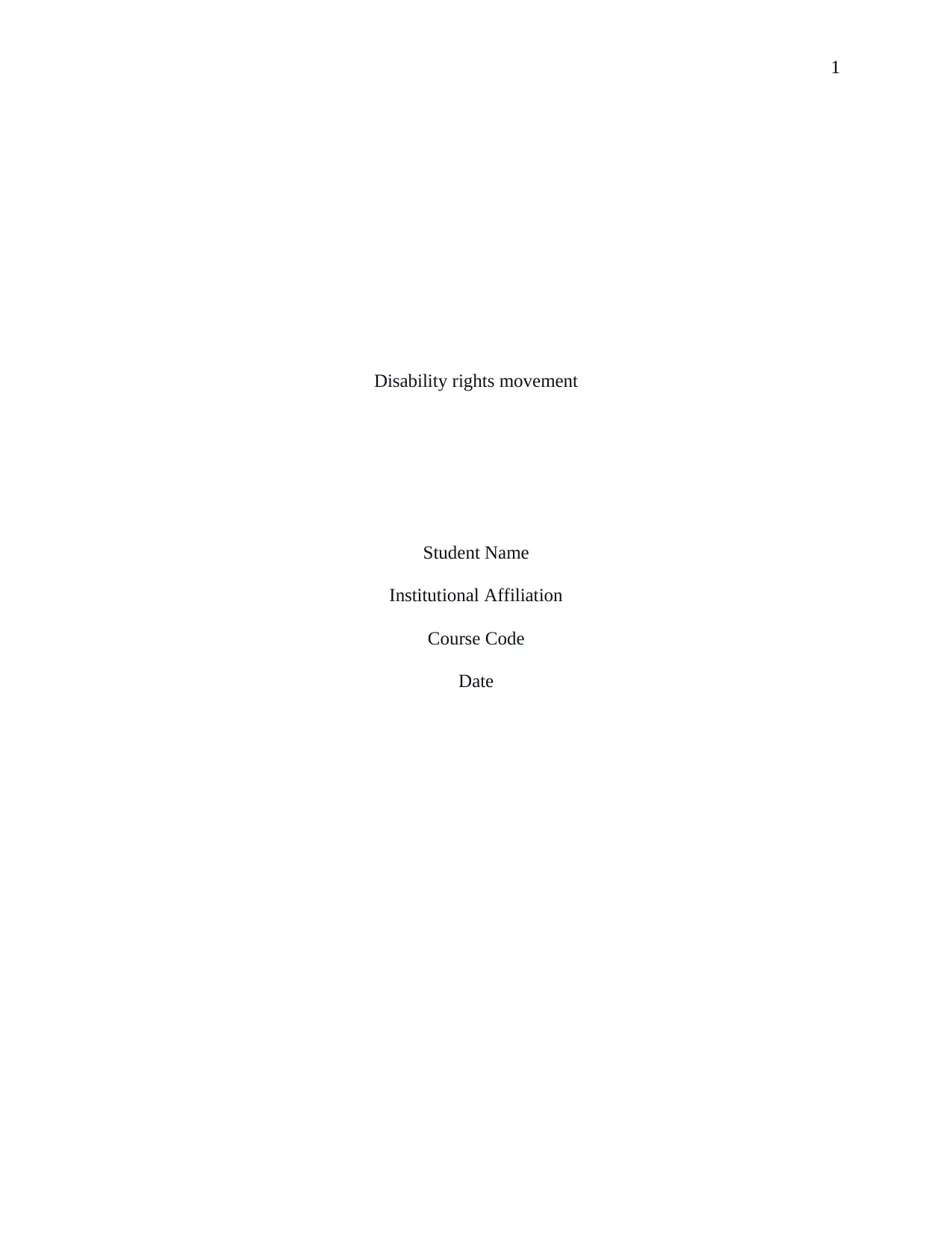
1
Disability rights movement
Student Name
Institutional Affiliation
Course Code
Date
Disability rights movement
Student Name
Institutional Affiliation
Course Code
Date
Secure Best Marks with AI Grader
Need help grading? Try our AI Grader for instant feedback on your assignments.
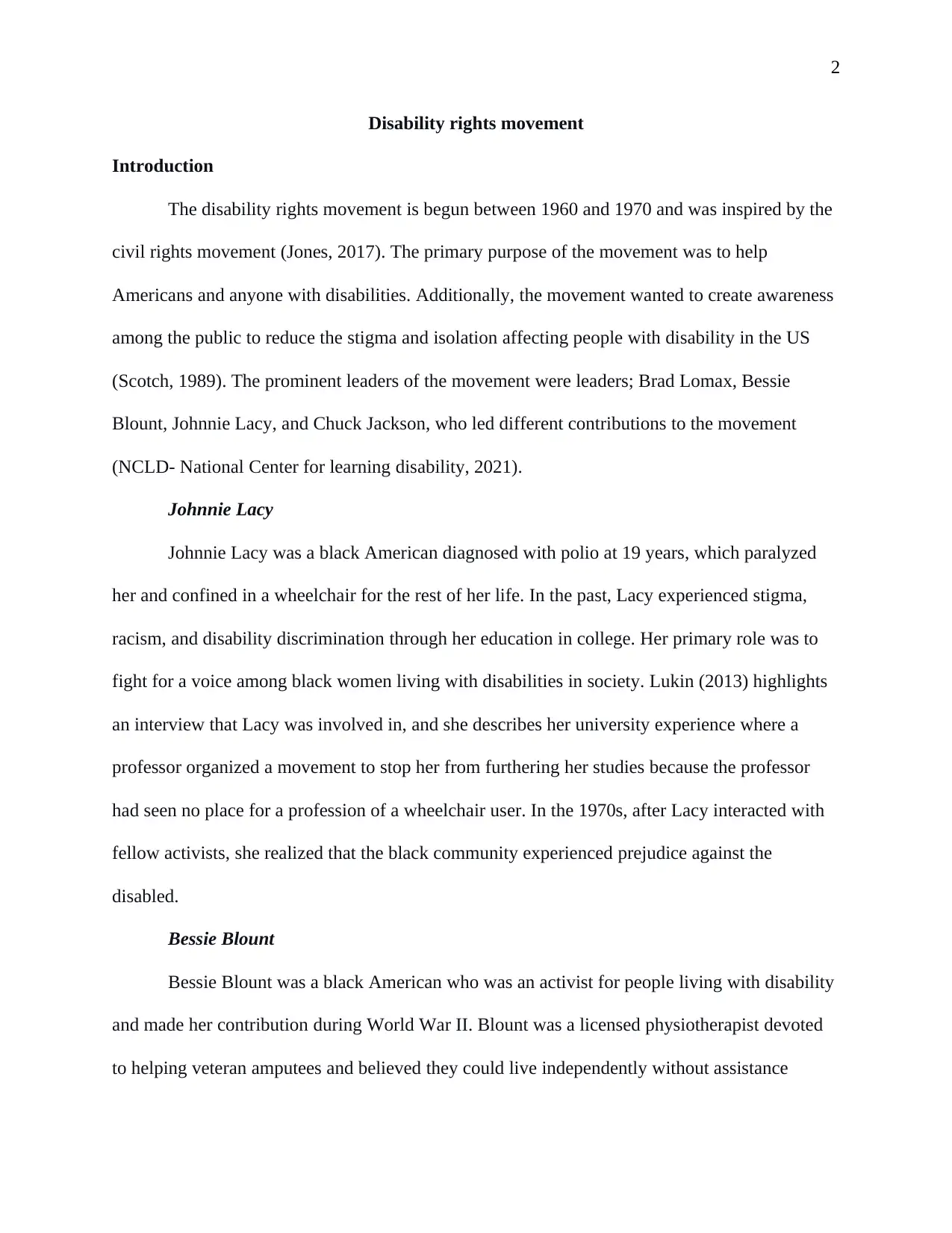
2
Disability rights movement
Introduction
The disability rights movement is begun between 1960 and 1970 and was inspired by the
civil rights movement (Jones, 2017). The primary purpose of the movement was to help
Americans and anyone with disabilities. Additionally, the movement wanted to create awareness
among the public to reduce the stigma and isolation affecting people with disability in the US
(Scotch, 1989). The prominent leaders of the movement were leaders; Brad Lomax, Bessie
Blount, Johnnie Lacy, and Chuck Jackson, who led different contributions to the movement
(NCLD- National Center for learning disability, 2021).
Johnnie Lacy
Johnnie Lacy was a black American diagnosed with polio at 19 years, which paralyzed
her and confined in a wheelchair for the rest of her life. In the past, Lacy experienced stigma,
racism, and disability discrimination through her education in college. Her primary role was to
fight for a voice among black women living with disabilities in society. Lukin (2013) highlights
an interview that Lacy was involved in, and she describes her university experience where a
professor organized a movement to stop her from furthering her studies because the professor
had seen no place for a profession of a wheelchair user. In the 1970s, after Lacy interacted with
fellow activists, she realized that the black community experienced prejudice against the
disabled.
Bessie Blount
Bessie Blount was a black American who was an activist for people living with disability
and made her contribution during World War II. Blount was a licensed physiotherapist devoted
to helping veteran amputees and believed they could live independently without assistance
Disability rights movement
Introduction
The disability rights movement is begun between 1960 and 1970 and was inspired by the
civil rights movement (Jones, 2017). The primary purpose of the movement was to help
Americans and anyone with disabilities. Additionally, the movement wanted to create awareness
among the public to reduce the stigma and isolation affecting people with disability in the US
(Scotch, 1989). The prominent leaders of the movement were leaders; Brad Lomax, Bessie
Blount, Johnnie Lacy, and Chuck Jackson, who led different contributions to the movement
(NCLD- National Center for learning disability, 2021).
Johnnie Lacy
Johnnie Lacy was a black American diagnosed with polio at 19 years, which paralyzed
her and confined in a wheelchair for the rest of her life. In the past, Lacy experienced stigma,
racism, and disability discrimination through her education in college. Her primary role was to
fight for a voice among black women living with disabilities in society. Lukin (2013) highlights
an interview that Lacy was involved in, and she describes her university experience where a
professor organized a movement to stop her from furthering her studies because the professor
had seen no place for a profession of a wheelchair user. In the 1970s, after Lacy interacted with
fellow activists, she realized that the black community experienced prejudice against the
disabled.
Bessie Blount
Bessie Blount was a black American who was an activist for people living with disability
and made her contribution during World War II. Blount was a licensed physiotherapist devoted
to helping veteran amputees and believed they could live independently without assistance

3
(NCLD, 2021). Blount came up with a tube that helped transport food to the patients' mouths,
which helped them gain self-esteem and independence. This was an invention/ assistive
technology that paved the way for more advancement for people living with disabilities.
Brad Lomax and Chuk Jackson
Lomax was an activist of the disability rights movement who was confined to a
wheelchair and participated in 504 Sit-In (NCLD, 2021). The Sit-In was meant to advocate for
disability rights which the federal government was to address the discrimination and other
disability rights for people living with disabilities. In 1977, there was a 28-day protest at the San
Francisco federal building, which advocated for disability rights. People with disabilities had
attended the protest but needed care and food (NCLD, 2021). Chuk worked with the community
in cooking and delivering meals to the disability rights advocates during the protests.
Demands of the movement
People living with disability experience exclusion in society due to their condition; I
think this can be due to their situation as some of them require aid in movement, hearing, and
other care, which is demanding. Therefore, one of the demands from the activists was citizenship
rights and participation (Sabatello & Schulz, 2014). This is one of the demands that was made
during the drafting of the movement. Consequently, it has been a global thing in the United
Nations and elsewhere that has been boosting the rights of people with a disability. Another
demand was understood well using the Vienna Declaration, which was held in 1993 (Sabatello &
Schulz, 2014). Among the aspects of the declaration that concerned people with a disability
included; the reinforcement of the notion of universality, indivisibility, and recognition of
interdependence.
(NCLD, 2021). Blount came up with a tube that helped transport food to the patients' mouths,
which helped them gain self-esteem and independence. This was an invention/ assistive
technology that paved the way for more advancement for people living with disabilities.
Brad Lomax and Chuk Jackson
Lomax was an activist of the disability rights movement who was confined to a
wheelchair and participated in 504 Sit-In (NCLD, 2021). The Sit-In was meant to advocate for
disability rights which the federal government was to address the discrimination and other
disability rights for people living with disabilities. In 1977, there was a 28-day protest at the San
Francisco federal building, which advocated for disability rights. People with disabilities had
attended the protest but needed care and food (NCLD, 2021). Chuk worked with the community
in cooking and delivering meals to the disability rights advocates during the protests.
Demands of the movement
People living with disability experience exclusion in society due to their condition; I
think this can be due to their situation as some of them require aid in movement, hearing, and
other care, which is demanding. Therefore, one of the demands from the activists was citizenship
rights and participation (Sabatello & Schulz, 2014). This is one of the demands that was made
during the drafting of the movement. Consequently, it has been a global thing in the United
Nations and elsewhere that has been boosting the rights of people with a disability. Another
demand was understood well using the Vienna Declaration, which was held in 1993 (Sabatello &
Schulz, 2014). Among the aspects of the declaration that concerned people with a disability
included; the reinforcement of the notion of universality, indivisibility, and recognition of
interdependence.

4
Another demand from the movement was the demand for respect for inherent dignity and
freedom to make personal decisions (Sabatello & Schulz, 2014). Basically, the activists
demanded inclusion and accessibility in society. Moreover, Article 9 elaborates on respecting
children living with disabilities, preserving their identity, and respecting and accepting everyone
living with a disability (Sabatello & Schulz, 2014). People with disability include the deaf and
blind; these people require attention as the deaf use sign language, and the blind require
assistance in their movement. However, the two sets of people adapt to the environment through
inclusion and respect, which enables them to raise their self-esteem in society.
Regarding the deaf in the community, the activists demanded that the deaf community be
regarded as a linguistic minority. This is because of the deaf use sign language only as
communication. To ensure that there is inclusion, there is a need to sensitize the community
about the language to enhance communication between the deaf and ordinary citizens.
Additionally, the activists demanded respect in society. I believe people with disabilities are a
minority community in society and deserve to be treated with respect like any other citizen. First,
they need to be educated, appreciated and included in functions and activities in society. These
are some things that make the minority feel respected and included in society, raising their self-
esteem.
Disability rights movement actions that brought changes
The movement's main objective was to empower and take control of their lives by
influencing social policies and ensuring inclusion (Winter, 2003). Winter (2003) highlights a
strategy that the movement took to ensure they achieved their main goal of bringing about
change in society; the strategy involved three phases; problem definition, solution, and
aftermath. The movement had the central problem of discrimination, exclusion, disrespect, and
Another demand from the movement was the demand for respect for inherent dignity and
freedom to make personal decisions (Sabatello & Schulz, 2014). Basically, the activists
demanded inclusion and accessibility in society. Moreover, Article 9 elaborates on respecting
children living with disabilities, preserving their identity, and respecting and accepting everyone
living with a disability (Sabatello & Schulz, 2014). People with disability include the deaf and
blind; these people require attention as the deaf use sign language, and the blind require
assistance in their movement. However, the two sets of people adapt to the environment through
inclusion and respect, which enables them to raise their self-esteem in society.
Regarding the deaf in the community, the activists demanded that the deaf community be
regarded as a linguistic minority. This is because of the deaf use sign language only as
communication. To ensure that there is inclusion, there is a need to sensitize the community
about the language to enhance communication between the deaf and ordinary citizens.
Additionally, the activists demanded respect in society. I believe people with disabilities are a
minority community in society and deserve to be treated with respect like any other citizen. First,
they need to be educated, appreciated and included in functions and activities in society. These
are some things that make the minority feel respected and included in society, raising their self-
esteem.
Disability rights movement actions that brought changes
The movement's main objective was to empower and take control of their lives by
influencing social policies and ensuring inclusion (Winter, 2003). Winter (2003) highlights a
strategy that the movement took to ensure they achieved their main goal of bringing about
change in society; the strategy involved three phases; problem definition, solution, and
aftermath. The movement had the central problem of discrimination, exclusion, disrespect, and
Secure Best Marks with AI Grader
Need help grading? Try our AI Grader for instant feedback on your assignments.
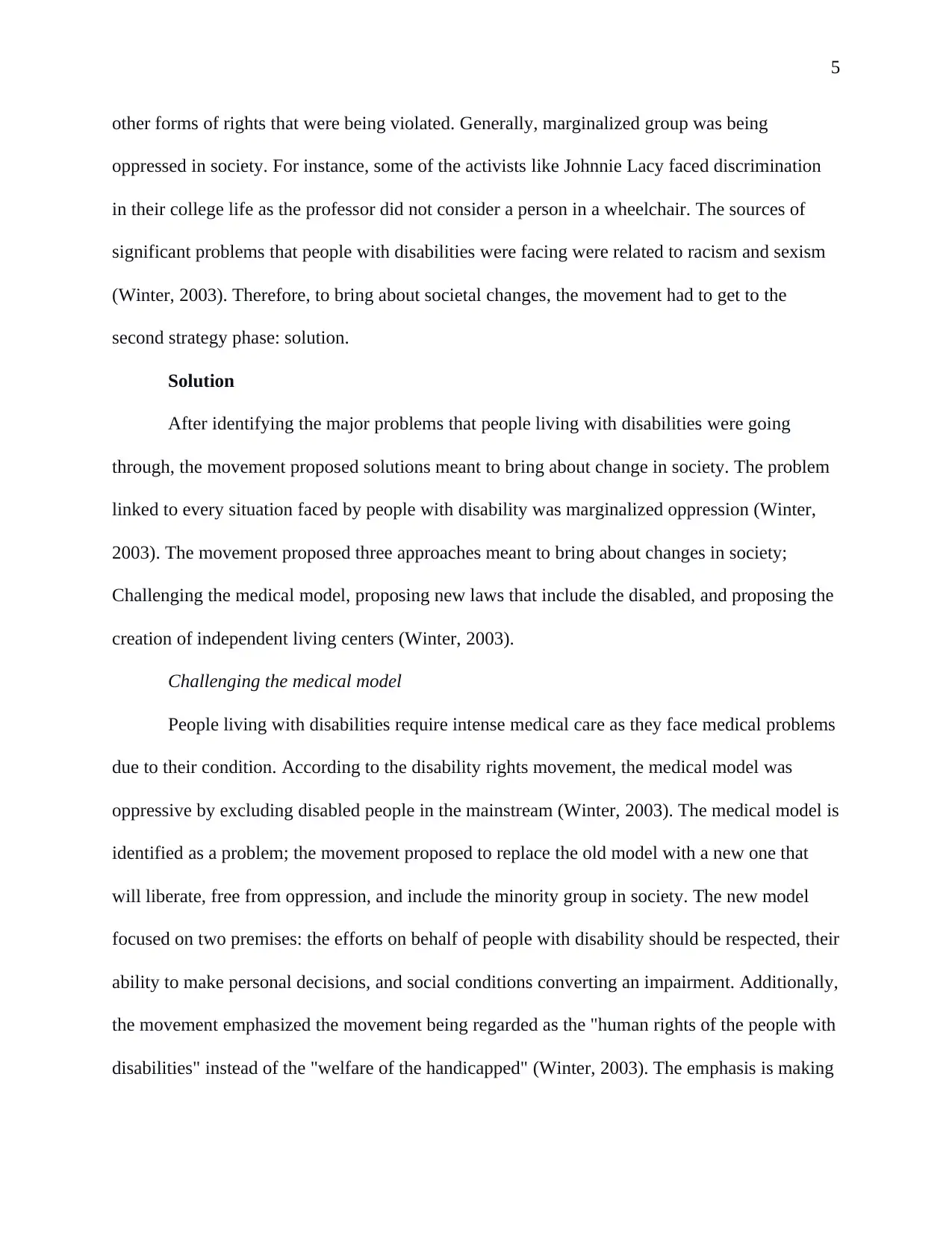
5
other forms of rights that were being violated. Generally, marginalized group was being
oppressed in society. For instance, some of the activists like Johnnie Lacy faced discrimination
in their college life as the professor did not consider a person in a wheelchair. The sources of
significant problems that people with disabilities were facing were related to racism and sexism
(Winter, 2003). Therefore, to bring about societal changes, the movement had to get to the
second strategy phase: solution.
Solution
After identifying the major problems that people living with disabilities were going
through, the movement proposed solutions meant to bring about change in society. The problem
linked to every situation faced by people with disability was marginalized oppression (Winter,
2003). The movement proposed three approaches meant to bring about changes in society;
Challenging the medical model, proposing new laws that include the disabled, and proposing the
creation of independent living centers (Winter, 2003).
Challenging the medical model
People living with disabilities require intense medical care as they face medical problems
due to their condition. According to the disability rights movement, the medical model was
oppressive by excluding disabled people in the mainstream (Winter, 2003). The medical model is
identified as a problem; the movement proposed to replace the old model with a new one that
will liberate, free from oppression, and include the minority group in society. The new model
focused on two premises: the efforts on behalf of people with disability should be respected, their
ability to make personal decisions, and social conditions converting an impairment. Additionally,
the movement emphasized the movement being regarded as the "human rights of the people with
disabilities" instead of the "welfare of the handicapped" (Winter, 2003). The emphasis is making
other forms of rights that were being violated. Generally, marginalized group was being
oppressed in society. For instance, some of the activists like Johnnie Lacy faced discrimination
in their college life as the professor did not consider a person in a wheelchair. The sources of
significant problems that people with disabilities were facing were related to racism and sexism
(Winter, 2003). Therefore, to bring about societal changes, the movement had to get to the
second strategy phase: solution.
Solution
After identifying the major problems that people living with disabilities were going
through, the movement proposed solutions meant to bring about change in society. The problem
linked to every situation faced by people with disability was marginalized oppression (Winter,
2003). The movement proposed three approaches meant to bring about changes in society;
Challenging the medical model, proposing new laws that include the disabled, and proposing the
creation of independent living centers (Winter, 2003).
Challenging the medical model
People living with disabilities require intense medical care as they face medical problems
due to their condition. According to the disability rights movement, the medical model was
oppressive by excluding disabled people in the mainstream (Winter, 2003). The medical model is
identified as a problem; the movement proposed to replace the old model with a new one that
will liberate, free from oppression, and include the minority group in society. The new model
focused on two premises: the efforts on behalf of people with disability should be respected, their
ability to make personal decisions, and social conditions converting an impairment. Additionally,
the movement emphasized the movement being regarded as the "human rights of the people with
disabilities" instead of the "welfare of the handicapped" (Winter, 2003). The emphasis is making
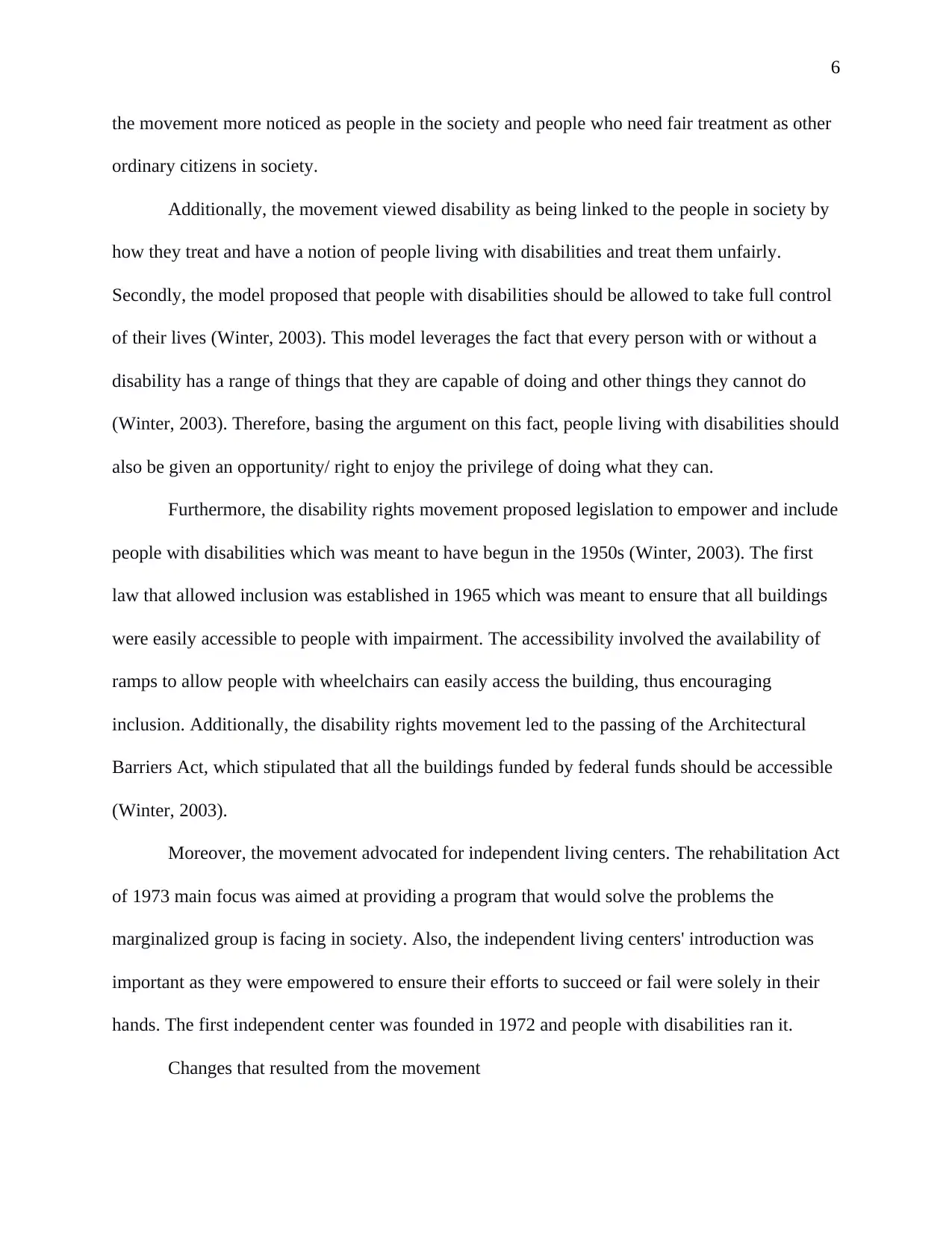
6
the movement more noticed as people in the society and people who need fair treatment as other
ordinary citizens in society.
Additionally, the movement viewed disability as being linked to the people in society by
how they treat and have a notion of people living with disabilities and treat them unfairly.
Secondly, the model proposed that people with disabilities should be allowed to take full control
of their lives (Winter, 2003). This model leverages the fact that every person with or without a
disability has a range of things that they are capable of doing and other things they cannot do
(Winter, 2003). Therefore, basing the argument on this fact, people living with disabilities should
also be given an opportunity/ right to enjoy the privilege of doing what they can.
Furthermore, the disability rights movement proposed legislation to empower and include
people with disabilities which was meant to have begun in the 1950s (Winter, 2003). The first
law that allowed inclusion was established in 1965 which was meant to ensure that all buildings
were easily accessible to people with impairment. The accessibility involved the availability of
ramps to allow people with wheelchairs can easily access the building, thus encouraging
inclusion. Additionally, the disability rights movement led to the passing of the Architectural
Barriers Act, which stipulated that all the buildings funded by federal funds should be accessible
(Winter, 2003).
Moreover, the movement advocated for independent living centers. The rehabilitation Act
of 1973 main focus was aimed at providing a program that would solve the problems the
marginalized group is facing in society. Also, the independent living centers' introduction was
important as they were empowered to ensure their efforts to succeed or fail were solely in their
hands. The first independent center was founded in 1972 and people with disabilities ran it.
Changes that resulted from the movement
the movement more noticed as people in the society and people who need fair treatment as other
ordinary citizens in society.
Additionally, the movement viewed disability as being linked to the people in society by
how they treat and have a notion of people living with disabilities and treat them unfairly.
Secondly, the model proposed that people with disabilities should be allowed to take full control
of their lives (Winter, 2003). This model leverages the fact that every person with or without a
disability has a range of things that they are capable of doing and other things they cannot do
(Winter, 2003). Therefore, basing the argument on this fact, people living with disabilities should
also be given an opportunity/ right to enjoy the privilege of doing what they can.
Furthermore, the disability rights movement proposed legislation to empower and include
people with disabilities which was meant to have begun in the 1950s (Winter, 2003). The first
law that allowed inclusion was established in 1965 which was meant to ensure that all buildings
were easily accessible to people with impairment. The accessibility involved the availability of
ramps to allow people with wheelchairs can easily access the building, thus encouraging
inclusion. Additionally, the disability rights movement led to the passing of the Architectural
Barriers Act, which stipulated that all the buildings funded by federal funds should be accessible
(Winter, 2003).
Moreover, the movement advocated for independent living centers. The rehabilitation Act
of 1973 main focus was aimed at providing a program that would solve the problems the
marginalized group is facing in society. Also, the independent living centers' introduction was
important as they were empowered to ensure their efforts to succeed or fail were solely in their
hands. The first independent center was founded in 1972 and people with disabilities ran it.
Changes that resulted from the movement

7
When the movement was founded, they identified the central problem and proposed a
solution, and in the third phase, there was the aftermath of the entire strategy. The third phase
records the aftermath/ results of the entire strategy.
Phase III (aftermath)
The disability rights movement's aftermath was observed although, not all their problems
were solved. For instance, the new social model did not have a positive impact compared to the
legislative acts which were seen to have a positive impact and acted on the inclusion and
empowerment of people with disabilities (Winter, 2003). The adoption of the social model was
partially a success; this is because the model rejects the notion that disability is a disease. As a
result, people with disabilities are always not involved in healthcare discussions.
On the other hand, the legislative was a success in its reforms. The laws that the
movement worked on passing, were passed and they made a great step of success to reduce
oppression among the marginalized group (Winter, 2003). Some of the laws like making
buildings accessible were a success although not all states observed the rule. Through the passing
of the Rehabilitation Act ADA (Americans with Disabilities Act) was formed which made
greater progress compared to the progress that had been made earlier (Winter, 2003). Since the
movement proposed the rights, the legislation has worked on improving the laws to ensure the
inclusion of people with disabilities. Lately, the court has ruled on fines to employers that tend to
showcase employment discrimination stating that every person is entitled to employment.
The disability rights movement is a movement that can be related to a group of minorities
in society. Therefore, choosing the movement to enable me to understand the history of
movement and determine whether there have been changes since its formation. Additionally, not
in all regions in the US that people with disabilities are enlightened about their rights and what
When the movement was founded, they identified the central problem and proposed a
solution, and in the third phase, there was the aftermath of the entire strategy. The third phase
records the aftermath/ results of the entire strategy.
Phase III (aftermath)
The disability rights movement's aftermath was observed although, not all their problems
were solved. For instance, the new social model did not have a positive impact compared to the
legislative acts which were seen to have a positive impact and acted on the inclusion and
empowerment of people with disabilities (Winter, 2003). The adoption of the social model was
partially a success; this is because the model rejects the notion that disability is a disease. As a
result, people with disabilities are always not involved in healthcare discussions.
On the other hand, the legislative was a success in its reforms. The laws that the
movement worked on passing, were passed and they made a great step of success to reduce
oppression among the marginalized group (Winter, 2003). Some of the laws like making
buildings accessible were a success although not all states observed the rule. Through the passing
of the Rehabilitation Act ADA (Americans with Disabilities Act) was formed which made
greater progress compared to the progress that had been made earlier (Winter, 2003). Since the
movement proposed the rights, the legislation has worked on improving the laws to ensure the
inclusion of people with disabilities. Lately, the court has ruled on fines to employers that tend to
showcase employment discrimination stating that every person is entitled to employment.
The disability rights movement is a movement that can be related to a group of minorities
in society. Therefore, choosing the movement to enable me to understand the history of
movement and determine whether there have been changes since its formation. Additionally, not
in all regions in the US that people with disabilities are enlightened about their rights and what
Paraphrase This Document
Need a fresh take? Get an instant paraphrase of this document with our AI Paraphraser
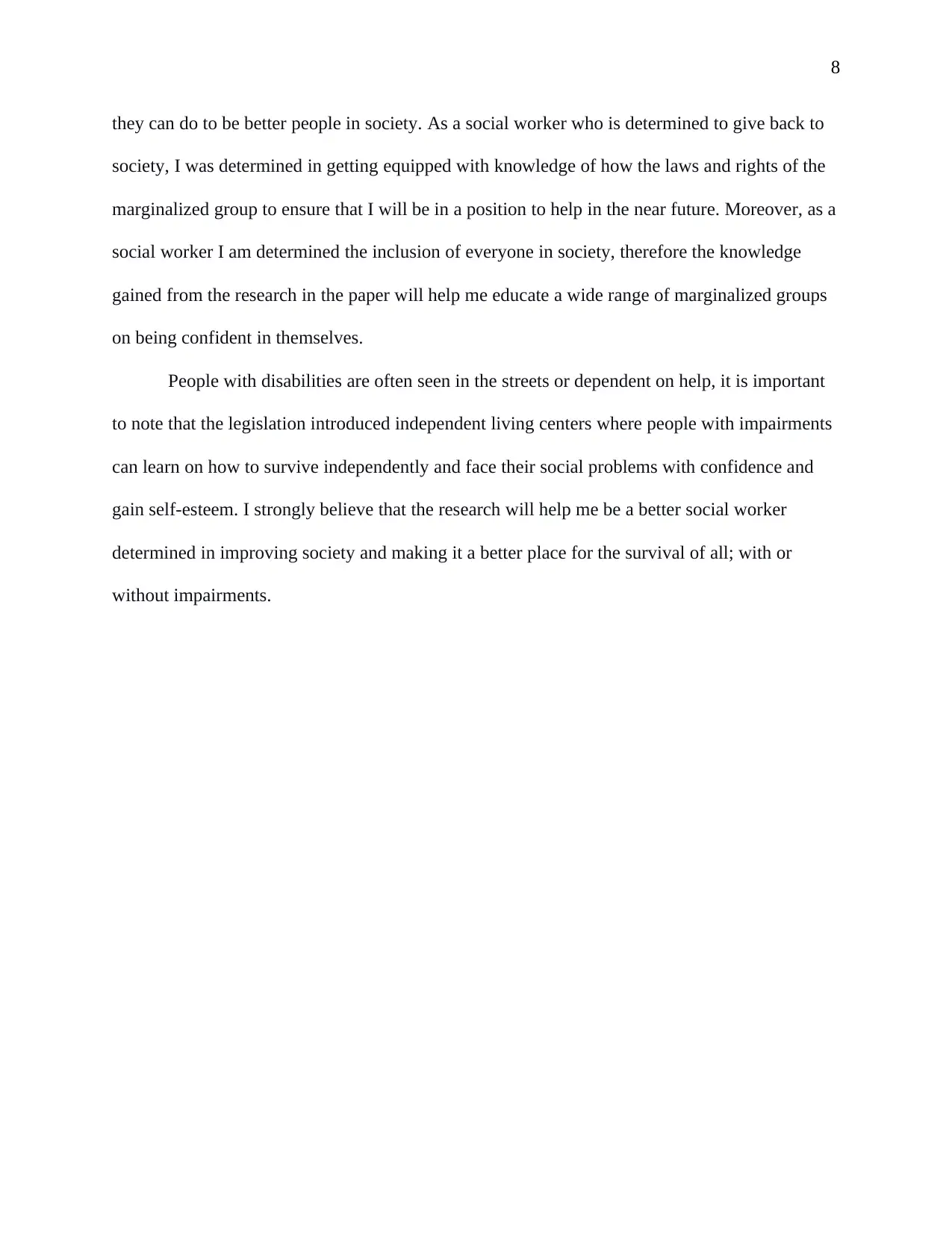
8
they can do to be better people in society. As a social worker who is determined to give back to
society, I was determined in getting equipped with knowledge of how the laws and rights of the
marginalized group to ensure that I will be in a position to help in the near future. Moreover, as a
social worker I am determined the inclusion of everyone in society, therefore the knowledge
gained from the research in the paper will help me educate a wide range of marginalized groups
on being confident in themselves.
People with disabilities are often seen in the streets or dependent on help, it is important
to note that the legislation introduced independent living centers where people with impairments
can learn on how to survive independently and face their social problems with confidence and
gain self-esteem. I strongly believe that the research will help me be a better social worker
determined in improving society and making it a better place for the survival of all; with or
without impairments.
they can do to be better people in society. As a social worker who is determined to give back to
society, I was determined in getting equipped with knowledge of how the laws and rights of the
marginalized group to ensure that I will be in a position to help in the near future. Moreover, as a
social worker I am determined the inclusion of everyone in society, therefore the knowledge
gained from the research in the paper will help me educate a wide range of marginalized groups
on being confident in themselves.
People with disabilities are often seen in the streets or dependent on help, it is important
to note that the legislation introduced independent living centers where people with impairments
can learn on how to survive independently and face their social problems with confidence and
gain self-esteem. I strongly believe that the research will help me be a better social worker
determined in improving society and making it a better place for the survival of all; with or
without impairments.

9
References
Jones, B. Emergence of the Disability Rights Movement Hist 498: Directed Reading
(Independent Study) June 26, 2017.
Lukin, J. (2013). Disability and blackness. The disability studies reader, 4, 308-315.
NCLD. 29 Jan, 2021. Honoring Black History month: Unsung Heroes of the Disability Rights
Movement. National Center for learning Disabilities. Retrieved from:
https://www.ncld.org/news/honoring-black-history-month-unsung-heroes-of-the-
disability-rights movement/#:~:text=These%20Black%20advocates%2C%20inventors
%2C%20and,to%20where%20we%20are%20today.
Scotch, R. K. (1989). Politics and policy in the history of the disability rights movement. The
Milbank Quarterly, 380-400.
Sabatello, M., & Schulz, M. (2014). A short history of the international disability rights
movement. Human rights and disability advocacy, 13-24.
Winter, J. A. (2003). The development of the disability rights movement as a social problem
solver. Disability Studies Quarterly, 23(1).
References
Jones, B. Emergence of the Disability Rights Movement Hist 498: Directed Reading
(Independent Study) June 26, 2017.
Lukin, J. (2013). Disability and blackness. The disability studies reader, 4, 308-315.
NCLD. 29 Jan, 2021. Honoring Black History month: Unsung Heroes of the Disability Rights
Movement. National Center for learning Disabilities. Retrieved from:
https://www.ncld.org/news/honoring-black-history-month-unsung-heroes-of-the-
disability-rights movement/#:~:text=These%20Black%20advocates%2C%20inventors
%2C%20and,to%20where%20we%20are%20today.
Scotch, R. K. (1989). Politics and policy in the history of the disability rights movement. The
Milbank Quarterly, 380-400.
Sabatello, M., & Schulz, M. (2014). A short history of the international disability rights
movement. Human rights and disability advocacy, 13-24.
Winter, J. A. (2003). The development of the disability rights movement as a social problem
solver. Disability Studies Quarterly, 23(1).
1 out of 9
Your All-in-One AI-Powered Toolkit for Academic Success.
+13062052269
info@desklib.com
Available 24*7 on WhatsApp / Email
![[object Object]](/_next/static/media/star-bottom.7253800d.svg)
Unlock your academic potential
© 2024 | Zucol Services PVT LTD | All rights reserved.